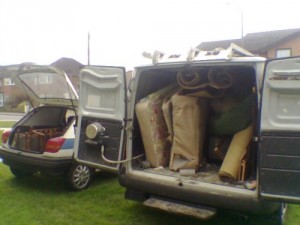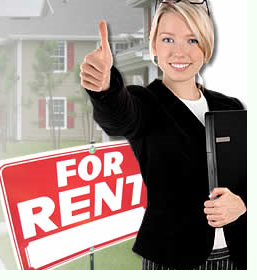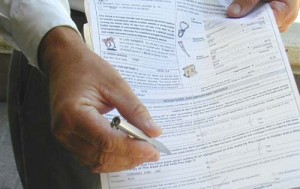Posted by Teresa on August 24, 2010 under Landlord Tips | 
 When it comes to refunding security deposits, most landlords and tenants will squabble at some point over the flooring in the rental unit. Carpets get stained or wear out, hardwood is easily scratched, and vinyl flooring doesn’t always hold up to tenant wear-and-tear.
When it comes to refunding security deposits, most landlords and tenants will squabble at some point over the flooring in the rental unit. Carpets get stained or wear out, hardwood is easily scratched, and vinyl flooring doesn’t always hold up to tenant wear-and-tear.
What is the best flooring choice for rental units? And how do you decide whether it’s time to switch to something new in your investment properties?
Ask a dozen landlords those two questions, and you’ll likely get a dozen answers. One thing most agree on is that carpet, while it can be the most economical choice, will often give you the most headaches.
Why? Carpet stains and odors are notoriously difficult to remove. A tenant’s pet, cigarette smoke and food odors are absorbed into carpets and padding and can permeate the air in the rental unit—as well as the sub-flooring below. However, in higher-end rentals, tenants may expect nice carpeting—just make sure your security deposit covers damage repair. Landlords know ruined carpeting can occur at every rent point.
- Individual adhesive-backed vinyl tiles are the first choice of many landlords—for bathrooms, kitchens or even the entire unit. They are inexpensive, easy to install and easy to replace. Some landlords we’ve talked to prefer commercial-grade tiles over the less-costly home variety because they hold up better.
- Tenants love hardwood floors. They look fantastic and add value to your rental unit, so if you have hardwood floors, make sure you advertise that fact! But what about caring for them? For homes that are lived in for years, it’s not as large an issue as it is for rental units that might have furniture moved in, out and around every 12 months. Some floor refinishers will recommend a harder topcoat if you inform them it’s a rental unit. Still, tenants can find ways to scratch and gouge the floors. Ask tenants to use floor protectors on furniture legs.
Furniture moving hint: When sliding furniture across a floor, put a thick sock on each leg to make it easier—and save the floor.
- Consider painting the hardwood floor instead. Floor paint is tough and easy to apply yourself. It’s less expensive than refinishing the floors, and between tenants you can repaint it quickly. Make sure you allow it time to cure completely before allowing the new tenant to move furniture in.
- Finally, landlords are starting to use concrete floors more often. They are inexpensive and easy to maintain. In addition, concrete is extremely durable and can be stained or colored to look very attractive. The key to a great looking concrete floor is proper polishing. Keep in mind that concrete floors tend to be hard and cold. Some landlords limit their use to kitchens and bathrooms.
Every landlord must balance initial cost, maintenance requirements and lifespan of flooring options before deciding which way to go. What issues have you encountered when replacing flooring in rental units?
Pre-screen all tenants as part of your standard application process. Background and credit checks will help ensure you rent to qualified tenants. For more landlord resources, including forms and information on tenant screening, turn to E-Renter.com.
Posted by Teresa on August 17, 2010 under Landlord Tips, Tenant Screening & Background Checks | 

- An incomplete tenant background check may not provide information on a lease applicant’s employment and income.
- Verifying the employer listed by a lease applicant will indicate his or her honesty—or lack of it. If you call the number provided and the telephone is not answered professionally (or at all) you might have reason to suspect the potential tenant is not being truthful. Certainly, exceptions apply—especially for small businesses.
- Long-term employment is an indicator of stability. However, recent economic difficulties have put many talented and dedicated employees out of work. Landlords may need to be flexible on their standards until the economy recovers. Requiring all tenants to have held their jobs for two years, for example, could mean a record number of vacant rental units for you.
- It can help you determine whether a potential tenant’s income source is lawful or illegal. Sure, it’s nice to have tenants who have plenty of cash to pay their rent. But if they’re not legally employed or cannot provide proof of income, like pay stubs, you could be asking for big trouble.
- Verifying employment can give you peace of mind. Renting to qualified tenants with jobs is the number one concern of most landlords. Confirming your lease applicants’ employment can keep your cash flow healthy and reduce turnover in your rental properties.
The best time to thoroughly check out a tenant’s employment situation is before the lease is signed. Following this tenant screening procedure on every applicant will ensure that you are not discriminating against any protected groups and that you will be leasing to only qualified tenants.
Posted by Teresa on August 9, 2010 under Landlord and Tenant FAQs, Rents and Deposits | 
 When a tenant informs you that they will not be renewing their lease, provide them with move-out instructions. Written notice of your expectations is always a good idea when it comes to dealing with tenants.
When a tenant informs you that they will not be renewing their lease, provide them with move-out instructions. Written notice of your expectations is always a good idea when it comes to dealing with tenants.
What Should Move Out Instructions Cover?
- The first item should be that a written move-out notice is required from the tenant. This helps clear up any possibility of confusion over dates and terms of the move-out.
- Ask the tenant to provide an address to which you can return the security deposit, after deducting legitimate expenses for repairs or cleaning.
- Inform the tenant you will be contacting them to conduct the move-out inspection. Let them know this is not optional: you will need the tenant to be present to initial and sign the inspection list.
- Let the tenants know that according to the terms of the lease, the unit must be returned to the same condition it was in when they moved it. If they’ve painted a different color on the walls, they need to repaint it. If they don’t clean the unit thoroughly, you can hire cleaners and deduct the fee from the tenant’s security deposit. Any damage repair costs will also be deducted from the deposit.
- If there is a fireplace in the unit, let tenants know they must have it professionally cleaned before moving.
- Tenants might not know that the last day of the lease is the day they must be out. Inform them that any extra days will be charged a prorated amount of their monthly rent. To calculate daily rent, divide the total rent by 30.
- Ask the tenant to set the thermostat at whatever temperature you prefer.
- Utilities need to be transferred to you or turned off, according to what works for you. If ther is another tenant lined up, then obviously you don’t need to turn them off. Let the tenant know to inform the utility companies, including gas, electric, cable, water and sewer, of the last day they will be in the space. Warn them not to have the utilities transferred or turned off until the end of the last day of their lease.
- Let the tenant know where to leave any extra trash and where to drop off the keys.
One thing landlords can count on is that eventually, all of their tenants will move out. Whether it’s a good thing or bad, it can be a smooth process when you’re organized and approach each move-out the same way.
Posted by Teresa on May 3, 2010 under Landlord Tips, Tenant Screening & Background Checks | 
 Landlords are happy to share information to help out their fellow rental property owners—especially when it comes to saving money, time, and trouble. Here is a round-up of some of our favorite easy-to-implement ideas.
Landlords are happy to share information to help out their fellow rental property owners—especially when it comes to saving money, time, and trouble. Here is a round-up of some of our favorite easy-to-implement ideas.
Out with the carpeting. If you own an older rental building or home, there are probably hardwood floors lurking beneath that worn-out carpeting you’re getting ready to replace. Get rid of the carpet, and you’ll never have to buy another roll of carpet again. And you don’t have to refinish the floors, either—you can simply paint them. Look for special floor paint in a dark color, like brown or dark grey. Just roll it on and cover a multitude of sins. And no more carpet burns or stains! Keep in mind this type of paint takes longer to cure, and is subject to scratching for about 30 days. So don’t blame your new tenants if they scratch an uncured floor when they move in!
Replacing cabinets, counters, or hardware? Check recycled building materials stores first! Most larger cities have Re-Stores, run by non profits like Habitat for Humanity. These stores carry all kinds of building materials, from shingles to clawfoot tubs. Besides great prices, these stores keep a lot of trash out of the landfill. It’s all about recycling these days. They’ll even take your leftover renovation materials as a donation—which could mean tax savings for you (check with your professional tax advisor, please).
Invest in a digital camcorder. The come in handy for rental property inspections, move-in/move-out checklist making, and for those times you need to prove a point to a tenant—or even to a judge! For example, a landlord we know was faced with tenants who didn’t believe he got complaints about their dog barking when they were away. A simple recording of the apartment door (with their number) and the barking coming from behind it was enough to prove his case.
Trust your gut: If you have a bad feeling about a potential tenant, save yourself time and worry—don’t rent to them. Just make sure that you are basing your decision on legally-binding reasons, such as length of employment, income, and credit history—not appearance, disability, or any other reason protected by the Fair Housing Act. The best way to treat applicants fairly is to require background screening, credit check, and criminal history check on all tenant applicants.
Posted by Teresa on April 30, 2010 under Landlord and Tenant FAQs, Landlord Tips | 
 Let’s say you’re a hands-off landlord, who keeps an eye on things outside your rental units; but generally, you don’t go inside until and unless you’re called upon to repair or replace something.
Let’s say you’re a hands-off landlord, who keeps an eye on things outside your rental units; but generally, you don’t go inside until and unless you’re called upon to repair or replace something.
If you’ve ever been surprised by the condition of your rental unit after a tenant moves out, perhaps you should consider inspecting your rental properties more often. Your lease probably stipulates that you are to be given access to the property with proper notice—so before barging in on your tenants, check your local and state laws.
Here are five reasons to inspect rental properties on a regular basis:
1. To see how many people actually live there. If you’re not around to check, who’s going to prevent unscreened tenants from living in your property? You might not ever know that your tenant, the sole lessee who pays the rent every month, actually has 3 friends living in your 1-bedroom apartment. Friends staying over are one thing, but you have the last word on who is allowed to live in your rental unit.
2. To check for undisclosed pets. The Internet is full of posts by tenants who aren’t supposed to have pets and hide them when the landlord stops by; or tenants who are approved for one cat, but have four. What about the 15-pound dog you approved that’sbeen replaced with a 75-pounder?
3. To check for illegal use of your property. Your tenants could be running a business from your rental property—from day care centers to illegal meth labs—and you need to know what’s going on. After all, you are liable for your tenants conduct and activity. Don’t find out when it’s too late that illegal commerce is taking place on your property.
4. To verify proper use of plumbing and electrical systems. Again, you don’t want a fire to be your tip-off that tenants have overloaded electrical outlets. And that small drip under the sink? If nobody tells you about it, you might soon be replacing the kitchen subflooring.
5. To replace smoke alarm and CO2 alarm batteries. Smart landlords keep spare batteries in their toolkits. Replacing worn out batteries can save lives.
From plumbing leaks to illegal drug activity—you truly never know what you’ll discover when inspecting your rental units. Preventing property damage and even loss of life is worth the time and effort involved, so call your tenants and schedule an inspection today!
Posted by Teresa on April 23, 2010 under Housing Trends, Landlord and Tenant FAQs | 
 Are pets welcome in your rental properties? If so, you may have noticed more tenant applicants who are moving their pets along with their kids and furniture. Pet ownership is up in the United States—and so is the percentage of rental units that are pet-friendly.
Are pets welcome in your rental properties? If so, you may have noticed more tenant applicants who are moving their pets along with their kids and furniture. Pet ownership is up in the United States—and so is the percentage of rental units that are pet-friendly.
But one reason for more pet-owning rental applicants may be the increase in foreclosures in the US. A typical track for pet owners is to get that first dog or cat when they buy their first home. But what about after they lose their job and their home—and must return to a rental lifestyle? Many are finding their pets are not welcome at rental units that otherwise work—and often, these socialized, housebroken family pets are being abandoned in shelters.
The rental market is difficult enough right now—why not remove one barrier to filling those vacant homes and apartments that are not making you any money? If you are a landlord who doesn’t accept pets, why not reconsider that policy? Studies show that allowing pets helps fill vacancies—so it’s good for business. And if you create a solid rental pet policy, you may find that the reasons you weren’t accepting pets (noise, damages, liability) were not valid after all.
Besides, it’s bad enough for a family to lose their home, for kids to move away from their neighborhood friends, and possibly switch to a new school. But it’s even worse when the comfort and companionship of a beloved pet is taken away, as well. Pet owners who are allowed to bring these family members along to a new rental are often so grateful, they are more than willing to agree to even the strictest of pet policies.
We’ve written about pet policies before. Check out the basics, and consider allowing pets in your rentals. You might find that with a large enough pet deposit to cover possible damage, plus clear rules and appropriate consequences established up front, pets in your rental properties can work for everyone!
Posted by Teresa on April 20, 2010 under General | 
 Congratulations—you have a new tenant for your just-vacated rental unit. And you have very little time to get it ready before move-in day. Here’s a handy checklist to follow, with every detail covered:
Congratulations—you have a new tenant for your just-vacated rental unit. And you have very little time to get it ready before move-in day. Here’s a handy checklist to follow, with every detail covered:
- First, make sure any trash or property left behind by the previous tenant is removed. Whether you hold it for the previous tenant to pick up, trash it, or donate it is up to you.
- Check the plumbing, heating, and A/C systems. Turn on every faucet, let the water run for few minutes, then turn it off. Make sure there are no leaks. Check around toilets, the dishwasher, and the garbage disposal, too. Be sure thermostats, filters and vents are working properly.
- Change the locks, if necessary. Some landlords never change locks between tenants—others always do. Depending on your situation, either install new locks, have the existing locks re-keyed, or just check the locks to make sure they work properly.
- Turn on appliances. Check the stove—does every burner heat up? Does the oven put out heat? Are the racks still there? How about the broiler pan? Also, run the dishwasher through a complete cycle—make sure it doesn’t get hung up or leak. Check the refrigerator and freezer to make sure they are cold, now warm. If your rental unit has a washer and dryer, turn them on too. Make sure the washer does not leak, and the dryer is properly vented.
- Check cabinet and drawer pulls in the kitchen and bathroom. Are any missing or loose?
- Look for torn or missing window screens. Check the windows, too. They should open and close easily. Locks must operate easily. Think of your tenants’ ability to open sticky windows or unclasp a stiff lock. In an emergency, windows and locks must operate smoothly and easily.
- Clean, clean, clean. Whether you do it yourself or hire an outside firm, clean the rental unit thoroughly. Give the toilets and tubs, showers, sinks, mirrors, and floors in the bathrooms a good scrubbing; same for the stove and sink, countertops and refrigerator, tile and flooring in the kitchen; then, clean windows and sills, baseboards and carpeting throughout the rest of the house or apartment.
- Check the storage area, shed, or garage—make sure there is no trash, dirt, or spider nests lurking behind. Ditto for outdoor living spaces, like balconies or patios.
- Check smoke and CO2 detectors for proper operation. Make sure fire extinguishers are in place.
- Finally, provide a new roll of toilet paper and paper towels—usually the first things people need in a new place. Your tenant will appreciate the thoughtful touch.
If you’re able, an inexpensive plant is a great welcome gift for your new tenant—and will start your relationship off on the right foot.
Posted by Teresa on April 16, 2010 under Landlord and Tenant FAQs, Landlord Tips, Rents and Deposits | 
 Ask ten landlords about rent due dates and last charges, and you’ll probably get ten different answers—none of them wrong. The thing about running a rental property business is that you get to establish your own procedures and practices to suit your needs—within the limits of federal, state, and local laws, of course. And if they don’t work for you, you can always change them (your procedures, not the law)!
Ask ten landlords about rent due dates and last charges, and you’ll probably get ten different answers—none of them wrong. The thing about running a rental property business is that you get to establish your own procedures and practices to suit your needs—within the limits of federal, state, and local laws, of course. And if they don’t work for you, you can always change them (your procedures, not the law)!
Here we present the results of an informal survey we conducted among four landlords we know:
Landlord #1: This landlord is a stickler for rules. Rent is due on the 1st of the month. It’s late on the 2nd, which is when he posts his pay or quit notice. He doesn’t mess around—and he has excellent cash flow numbers to back up his policy. “A grace period means rent isn’t due until the grace period is over,” he says. Using an online rent payment system helps—all of his tenants arrange to pay their rent online on the 1st of each month.
Landlord #2: Rent is due on the 1st, and a 10% late fee is tacked on the 4th. Each day after, $10 more is added to the late fees. The eviction notice, however, is posted on the door on the 3rd of the month—to encourage payment.
Landlord #3: With many older tenants who depend on Social Security and Section 8, this landlord knows that rent due on the 1st doesn’t work. So, while rent is due on the 1st, there is a grace period until 5 p.m. on the 4th. On the 5th, the 3-day eviction notice is posted; if rent is paid during that time, the landlord adds a $50 late fee.
Landlord #4: This landlord wins the “flexibility” award. Rent due dates are negotiated with each tenant during the lease signing, depending on when the tenant can pay each month. Some have Social Security arriving on the 8th of the month, so that is when their rent is due. Others are paid on the 1st and 15th of the month, so the rent is due on the 2nd. Still others want to pay out of the second paycheck, so theirs is due on the 16th. All of these due dates would cause some landlords to pull their hair out—but this woman says when it comes to money that is owed to her, she can easily keep track of it.
The most important advice these landlords give is to check your local laws—you may not be able to charge a late fee at all, and many states will dictate when you may post an eviction notice.
Posted by Teresa on March 27, 2010 under Landlord Tenant Lawsuits, Landlord Tips | 
 Learning by others’ mistakes is a classic move. So read on for a few errors landlords can avoid—just because others have already made them.
Learning by others’ mistakes is a classic move. So read on for a few errors landlords can avoid—just because others have already made them.
Security deposits: Seems like security deposit issues are a top-5 cause of disputes between landlords and tenants. The problem can often be traced to miscommunications and unspoken expectations. Tenants sometimes assume they will receive 100% of their deposit back. It’s not their fault if they don’t understand how it works—it’s your job to fully explain the process, and what they stand to lose if they damage or otherwise alter the condition of the rental unit after they move in.
Have new tenants sign a statement that they have reviewed and understand your security deposit policy, move-in and move-out inspection lists, and then follow up with a thorough initial walk-through of the rental unit. Take photos and have tenants initial the condition of each item on the list. When they are ready to move out, schedule another walk-through with the tenant, establish damages and take more photos.
Failure to document, document, document. Keep pristine records—you never know when you’ll need them. Each tenant’s application, background screening and credit check report, lease documents and correspondence should be kept on file until three years after the end of the lease. Keep notes of emails and notes conversations, too (aside from the “nice day, huh?” conversations). Just keeping good records shows that you’re serious about your business—and someday, if you find yourself in front of a judge over a landlord/tenant dispute, it could work in your favor. It certainly can’t hurt!
Unintentional discrimination: Being discriminatory is not always a planned situation. Some landlords may mean well when asking a disabled tenant applicant about their wheelchair or asking if a 2 potential tenants plan to have children—but those questions themselves can be considered illegal. By avoiding personal questions of applicants, you could be avoiding possible legal trouble.
Not treating all tenants equally: Not only is it easier to be consistent in how you deal with tenants, it can also keep you safe legally. Don’t allow Tenant A to pay rent four days late when you never allow Tenant B a single day of leeway. Don’t enforce your “no smoking” rule for one tenant and not the others. Don’t fix a water drip immediately in the apartment of the tenant you like to talk to, but make an “unstable” tenant wait a week for a repair. Be fair and enforce all rules the same way to all your tenants. It’s easier to explain to a tenant that you’re sorry, but you have to apply the rules equally—and it can help you avoid a fair housing complaint, and a call to your lawyer!
Posted by Teresa on March 12, 2010 under Landlord and Tenant FAQs, Landlord Tips | 
 Not every landlord or property management company requires tenants to hold renter’s insurance policies. And according to some reports, the majority of tenants do not have renter’s insurance. What are the advantages to requiring tenant insurance? Are there any disadvantages?
Not every landlord or property management company requires tenants to hold renter’s insurance policies. And according to some reports, the majority of tenants do not have renter’s insurance. What are the advantages to requiring tenant insurance? Are there any disadvantages?
First, the cost for renter’s policies is solely borne by the tenant, and is only $15-$20 per month, on average. So, while there are those tenants who cannot afford it, are they the best fit for your rental properties? An insurance requirement automatically screens out the potential tenants who have financial difficulties.
What’s in it for the tenant? Just as homeowners who have property insurance to protect against loss due to fire, injury or natural disaster, tenants with insurance enjoy a level of protection and peace of mind that is well worth the investment. In the event of a fire, for example, replacement property can easily be obtained, helping the tenant begin again with necessities like furniture and clothing. Some policies offer temporary housing coverage, so the tenant can stay in a hotel worry-free.
Now, let’s imagine that the fire in this example was caused by the tenant’s negligence. Without insurance, the tenant would be responsible for reimbursing the landlord’s insurance company for any damages caused by the fire—which could be tens of thousands of dollars. With renter’s insurance, the tenant and landlord are both covered.
What’s in it for the landlord? Certainly, landlords who require tenants to carry insurance will have fewer hassles in the event of a disaster. Tenant insurance also adds a layer of protection when a visitor is injured in a tenant’s unit, for example. That visitor will likely seek damages from the tenant’s policy, rather than the landlord’s. If an uninsured tenant’s negligence results in major damage (like a flood or fire) to a multi-unit building, the landlord would be liable for all damages to the structure as well as other tenant’s injuries or losses.
Rental property owners—there are many advantages of requiring tenants to hold renter’s insurance—with more than just minimum coverage. Think about the potential for large losses due to the tenant’s negligence, and have your insurance agent advise on the minimum. Just make sure to require the same for all tenants. Together, the owner’s and tenant’s policies offer both parties a broader range of protection.
 When it comes to refunding security deposits, most landlords and tenants will squabble at some point over the flooring in the rental unit. Carpets get stained or wear out, hardwood is easily scratched, and vinyl flooring doesn’t always hold up to tenant wear-and-tear.
When it comes to refunding security deposits, most landlords and tenants will squabble at some point over the flooring in the rental unit. Carpets get stained or wear out, hardwood is easily scratched, and vinyl flooring doesn’t always hold up to tenant wear-and-tear.








